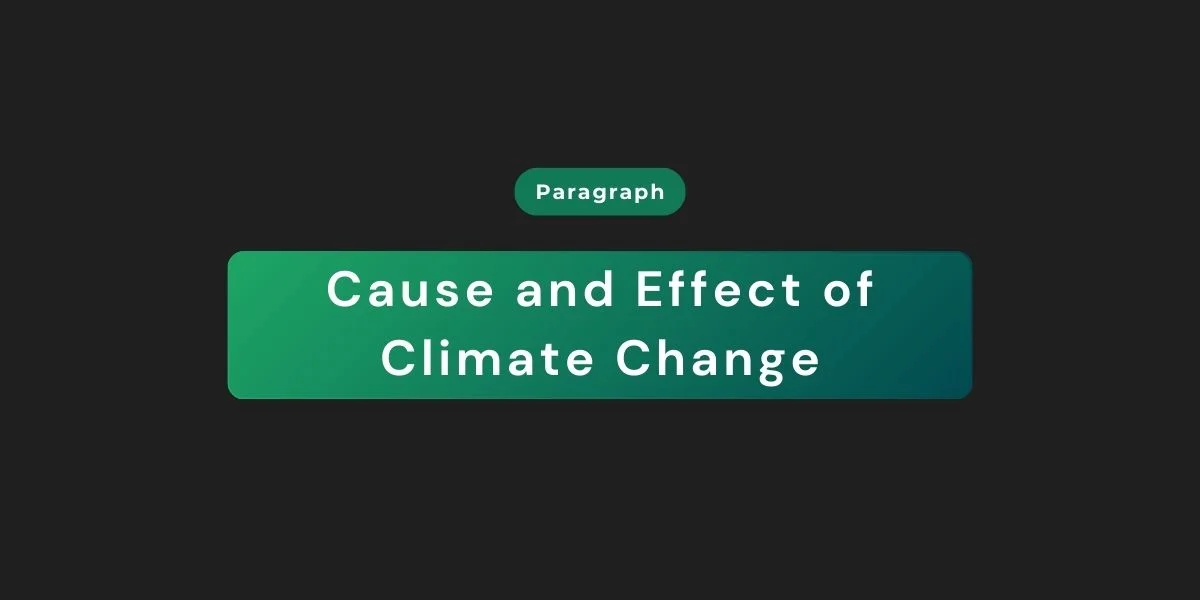Cause and Effect of Climate Change paragraph for HSC
These cause and effect paragraph topics are written with informative data. Students can get a clear idea about the topic of climate change. This way, they can write properly on the exam. Here is the Cause and Effect of Climate Change paragraph:
The Earth’s fever is rising, and we’re the doctors who must administer the cure. What was considered earlier to be a faraway issue, climate change now stands at our threshold as an immediate global crisis. With the mercury of our planet on an unprecedented rise, we find ourselves in a transformational era that touches almost every nook and corner of our world—from melting ice caps in the Arctic to rising seas washing away entire coastal communities in Bangladesh.
Of all the various threads that go into the tapestry of global challenges, it is one that weaves through every component part of the planet’s ecosystem and human society. This phenomenon, characterized by long-term temperature and weather pattern shifts, has already begun to define our times.As such, it is human activities, particularly those that have been increasing the level of greenhouse gases in the atmosphere over time, that form the root of climate change, hence creating a complex network of causes and effects stretching across the globe in every direction.
Climate change is mainly due to burning fossil fuels, which include coal, oil, and natural gas. These release carbon dioxide, one of the most powerful greenhouse gases into the atmosphere. The course of unabated use of fossil fuels started at the beginning of the Industrial Revolution, driving our homes, industries, and vehicles at the expense of the stability of our planet’s climate. Results from deforestation, another huge factor in this, not only release stored carbon but also lower the Earth’s capacity to absorb CO2. Other greenhouse gases, including methane and nitrous oxide, are released by industrial processes and other industries associated with manufacturing and agriculture.
These emissions combine to have sweeping and multiplying effects. Global temperatures have risen about 2°F (1°C) since the late 1800s, with more than two-thirds of that warming occurring since 1970. Whenever temperature averages seem to raise a little, such a small rise has alarming consequences for the sensitive balance of our planet’s systems.
One of its more dramatic manifestations is seen in the melting of the polar ice caps and mountain glaciers. As these ice reservoirs get smaller, they contribute to the sea-level rise, putting coastal communities around the world at risk. Low-lying countries like Bangladesh take the brunt of the crisis. The immense length of its coastline and heavily populated delta regions have turned sea-level rise into an existential threat to Bangladesh. This is further exacerbated by exposure to stronger and ever more frequent tropical cyclones, which are being catalyzed by rising ocean temperatures.
With the warming, precipitation becomes disrupted and drives both droughts and floods. Countries that are used to regular rainfall may experience an extended dry spell, whereas others experience deluges that overwhelm the infrastructure and natural drainage. These changes have profound implications for agriculture, potentially triggering food insecurity on a global scale. In Bangladesh, for instance, crop yields are already being reduced by changed patterns of monsoon and saltwater intrusion in the coastal areas. This is putting at risk the livelihoods of millions of farmers.
Most ecosystems worldwide are already strained to cope with such massive changes. For plant and animal species, the last resort for survival is to migrate internationally into more hospitable habitats or face extinction as temperatures change. Specifically, the rainforests of the ocean—also called coral reefs—are already being affected by ocean warming and acidification from increased CO2 absorption. The loss of such diverse ecosystems ripples through marine life and on the communities dependent on them for food and livelihoods.
The same period has seen a rise in the occurrence of extreme weather events. What were formerly rare heatwaves are now frequent and lethal. Consider the 2003 heatwave in Europe that killed over 70,000 people, an ugly reminder of what climate change costs in human lives. Warmer ocean waters make hurricanes and typhoons stronger, providing an extra push of energy. Destruction from these storms alone, as seen in the case of Hurricane Katrina in 2005 and Cyclone Amphan in 2020, does leave a clear indication of how susceptible our infrastructure and people have become against such an increasing tide of natural disasters..
It is also a threat multiplier in the case of climate change, which will increase already existent social and economic inequalities. Poor developing countries are generally the least contributors to historic emissions, yet are hardest hit by the ravages of a changing climate. In Bangladesh, internally induced migration is occurring due to climate-induced disasters or environmental degradation, wherein people abandon the more and more uninhabitable coastal areas for overcrowded urban centers. This not only disadvantages urban infrastructure but also leads to dislocation of traditional ways of life and cultural practices.
Being a global problem, climate change requires an international response in cooperation with all countries. Probably the most iconic step toward this goal was made by the Paris Agreement in 2015, in which countries committed themselves to keeping global average rises in temperatures well below 2°C above pre-industrial levels. Current commitments leave the world far off this target, underlining the demand for greater ambition.
Stopping climate change will require a multi-faceted approach. Massive substitution of solar and wind energy in lieu of fossil fuel-based energy for mitigating GHG emissions is needed. Improved energy efficiency in every sector—from building construction to transport—can bring down carbon emissions significantly. Reforestation and afforestation might sequester carbon while bringing back some of the most vital ecosystems. Further, innovations in agriculture—drought-resistant crops that will resist constant rainfalls in times when local culture has prepared for drought to sustainable agriculture techniques—are similarly necessary for food security and resilience in changing times.
Decisions we take today set a course for generations to come in light of climate change. The challenge is perhaps the biggest, but so is the opportunity to build a far more sustainable and equitable future. More nuanced understandings of the complex causes and effects of climate change enable things like more focused ways of solving them and underestimating the global cooperation needed to ward off existential danger. Now is the time to act, for we are at the crossroads which will determine the future of our planet and all its inhabitants.

